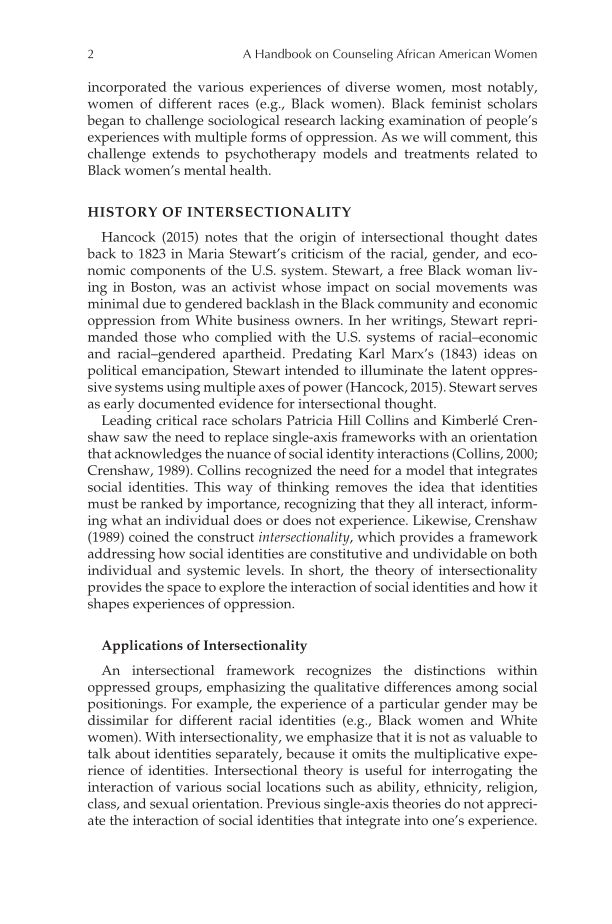2 A Handbook on Counseling African American Women incorporated the various experiences of diverse women, most notably, women of different races (e.g., Black women). Black feminist scholars began to challenge sociological research lacking examination of people’s experiences with multiple forms of oppression. As we will comment, this challenge extends to psychotherapy models and treatments related to Black women’s mental health. HISTORY OF INTERSECTIONALITY Hancock (2015) notes that the origin of intersectional thought dates back to 1823 in Maria Stewart’s criticism of the racial, gender, and eco- nomic components of the U.S. system. Stewart, a free Black woman liv- ing in Boston, was an activist whose impact on social movements was minimal due to gendered backlash in the Black community and economic oppression from White business owners. In her writings, Stewart repri- manded those who complied with the U.S. systems of racial–economic and racial–gendered apartheid. Predating Karl Marx’s (1843) ideas on political emancipation, Stewart intended to illuminate the latent oppres- sive systems using multiple axes of power (Hancock, 2015). Stewart serves as early documented evidence for intersectional thought. Leading critical race scholars Patricia Hill Collins and Kimberlé Cren- shaw saw the need to replace single-axis frameworks with an orientation that acknowledges the nuance of social identity interactions (Collins, 2000 Crenshaw, 1989). Collins recognized the need for a model that integrates social identities. This way of thinking removes the idea that identities must be ranked by importance, recognizing that they all interact, inform- ing what an individual does or does not experience. Likewise, Crenshaw (1989) coined the construct intersectionality, which provides a framework addressing how social identities are constitutive and undividable on both individual and systemic levels. In short, the theory of intersectionality provides the space to explore the interaction of social identities and how it shapes experiences of oppression. Applications of Intersectionality An intersectional framework recognizes the distinctions within oppressed groups, emphasizing the qualitative differences among social positionings. For example, the experience of a particular gender may be dissimilar for different racial identities (e.g., Black women and White women). With intersectionality, we emphasize that it is not as valuable to talk about identities separately, because it omits the multiplicative expe- rience of identities. Intersectional theory is useful for interrogating the interaction of various social locations such as ability, ethnicity, religion, class, and sexual orientation. Previous single-axis theories do not appreci- ate the interaction of social identities that integrate into one’s experience.
Document Details My Account Print multiple pages
Print
You have printed 0 times in the last 24 hours.
Your print count will reset on at .
You may print 0 more time(s) before then.
You may print a maximum of 0 pages at a time.



















































































































































































































































































































































